Ballistics
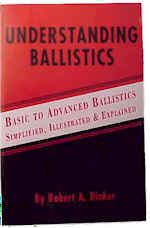 I always find myself using basic ballistic equations and tables. At a minimum, these little gems are interesting and help build a foundation of understanding of firearms. More so, they become frequently used tools to help sight in firearms, examine cartridge application before purchase, etc.
I always find myself using basic ballistic equations and tables. At a minimum, these little gems are interesting and help build a foundation of understanding of firearms. More so, they become frequently used tools to help sight in firearms, examine cartridge application before purchase, etc.
“Understanding Ballistics”, by Robert A Rinker – 2nd revised edition 1998 is an inexpensive source of information, and available through Amazon.Com. I was always impressed by Sierra’s coverage of ballistics in their 50th Anniversary manual but, because “Understanding Ballistics” is entirely dedicated to the subject, it provides more general coverage and a lot more background. At about $16, it’s a pretty good deal.
Suppliers on the Internet
I am always trying to add to my list of quality mail order and Internet suppliers. Quality, in this context, is any organization that –
Sells at competitive prices
Stocks the majority of Items they catalog
Enter orders same, or next day max
Take orders online
Is accessible when problems arise
Lock Stock & Barrel – Valentine, Nebraska has been around since 1975. They have a well designed and maintained online catalog, and carry a good selection of products. So far so good at meeting the criteria listed above. The first order was only bullets, but a pretty good list of Berger,Remington bulk, Nosler, Hornady, and Sierra product – in a variety of caliber. Everything was shipped from stock, including some that have typically been a pain in the neck for me to locate.
The second order was for a set of Leupold scope mounts for the TC and a reloading manual on CD-ROM, which were both delivered quickly. The prices are significantly lower than either Midway or Graf. About time to try ordering the product that means death to most suppliers, smokeless powder. I’ll keep you posted.
It is getting just about impossible to purchase firearms related items in this part of California. With sales tax running up to 9.2% and large stores unwilling to stock many nuts and bolts items, it’s more cost effective and there is better service available via mail and Internet.
I use two local shops when I buy guns, one for handguns and one for rifles. Neither is very inexpensive, but both always have a few of everything they sell, so I don’t have to buy a gun that’s been sitting in a display case, or dry fired 1000 times, or has etched finger prints, or… But at $23 for a pound of RL25 or IMR 7828, plus tax, I’ll pay the premium on guns, and not use either store for much else.
The Contender .30/30 Vs the real .30/30 ?
 I’m convinced everyone owns, or has owned, a .30/30. People hide them in the back of closets, stow them away in attics, lock them in cases under beds, and never, ever admit to owning them – unless of course they live in the North East, don’t care what other people think, and use one every deer season. Today, I find myself with two, a traditional Marlin 336, and a less traditional Thompson Center Contender pistol.
I’m convinced everyone owns, or has owned, a .30/30. People hide them in the back of closets, stow them away in attics, lock them in cases under beds, and never, ever admit to owning them – unless of course they live in the North East, don’t care what other people think, and use one every deer season. Today, I find myself with two, a traditional Marlin 336, and a less traditional Thompson Center Contender pistol.
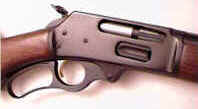 At 40 years of age, submerged in a flood, sold, repurchased and dragged all over the country, my Marlin 336 is still both younger, and in a lot better shape than I am. But, then again, I wasn’t factory refurbished 20 years ago.
At 40 years of age, submerged in a flood, sold, repurchased and dragged all over the country, my Marlin 336 is still both younger, and in a lot better shape than I am. But, then again, I wasn’t factory refurbished 20 years ago.
The Marlin, like the Winchester 94, is the real deal for a short range utility rifle. Of course there is Marlin’s unique Micro-Groove® rifling and closed top receiver. The carbine weighs less than 7 lbs., unfortunately has an almost matching 6.25 lb. trigger pull, a 6 shot mag capacity, and a short 20″ barrel. It’s quick pointing, easy to clean and there isn’t a much to break or fall off – good enough for deer and black bear, and probably a whole lot more.
 The quality of the gun was excellent as originally shipped. Makes me wonder why a gun that sold for less than $100 could have little things like a clean barrel stamp, when the super duper new generation Weatherby I own, looks like the stamp was made with a blunt chisel. The Marlin feels solid. It smells like steel, wood and oil – it’s just a nice mature piece of machinery.
The quality of the gun was excellent as originally shipped. Makes me wonder why a gun that sold for less than $100 could have little things like a clean barrel stamp, when the super duper new generation Weatherby I own, looks like the stamp was made with a blunt chisel. The Marlin feels solid. It smells like steel, wood and oil – it’s just a nice mature piece of machinery.
The .30/30 Contender is a relatively new addition to my collection. I had just finished writing an article on the .223 Contender, and I wanted to cover a larger bore cartridge to bring another perspective to the pistol. So I ordered a new barrel through the E.Arthur Brown Company. I’m sure Contender and Encore users are familiar with them an excellent source of barrels, accessories and gunsmith services.
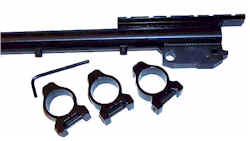 It took only a couple of days for me to received a Super 14″ barrel, chambered for the .30/30 cartridge, with a TriForce scope mount/ring setup installed, and the barrel’s original metallic sights packed along in a small plastic bag.
It took only a couple of days for me to received a Super 14″ barrel, chambered for the .30/30 cartridge, with a TriForce scope mount/ring setup installed, and the barrel’s original metallic sights packed along in a small plastic bag.
The TriForce mount employs three Weaver style rings. Socket head fasteners secure both notched mount and rings.
There wasn’t a ring location, in the series of mount notches, that would put three rings on the Burris scope tube. I secured the scope with two rings, but never ran into a problem with the scope slipping, or fasteners working loose. The instructions packaged with the TriForce mount suggested it could be installed with the overhang to the front, or to the rear of the firearm. I would have preferred no overhang. The extra material gives a “one size fits all” appearance, and gets in the way when cocking the hammer.
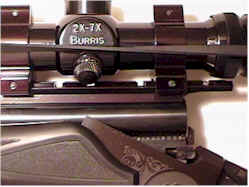
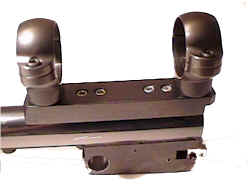
After using both set ups, I think I’m more comfortable with the Leupold dovetail type mounts, horizontally split rings and Torx fasteners. They have a cleaner appearance and the dual dovetail rings really lock in place. Due to time constraints, I used the TriForce for this article, but I’ve ordered a Leupold mount/ring set for more permanent service.
 As configured, the Contender tips the scales at 4.75 lbs., 2.25 pounds less than the carbine. The cartridge / gun combination only generates 11 pounds of recoil, but as you can see in this short movie clip, it has pronounced muzzle jump. Amazingly, it is still an easy gun to shoot.
As configured, the Contender tips the scales at 4.75 lbs., 2.25 pounds less than the carbine. The cartridge / gun combination only generates 11 pounds of recoil, but as you can see in this short movie clip, it has pronounced muzzle jump. Amazingly, it is still an easy gun to shoot.
 Barrels from any legitimate source seem to fit and lock up solidly, pounding from heavy use seems to have no effect at all, and high pressure cartridge chambering are routine. Fit and finish is also quality and, as denoted by the photo-etch cougar engraving on the receiver, they are apparently designed to defend against large members of the cat family, and/or mid size cars from Lincoln Mercury.
Barrels from any legitimate source seem to fit and lock up solidly, pounding from heavy use seems to have no effect at all, and high pressure cartridge chambering are routine. Fit and finish is also quality and, as denoted by the photo-etch cougar engraving on the receiver, they are apparently designed to defend against large members of the cat family, and/or mid size cars from Lincoln Mercury.
.30/30 Cartridge Overview
 In ballistic terms, the .30/30 is not a barn burner – I know, not a surprise or a unique observation. Over a hundred years old, stoop shouldered and of diminutive powder capacity, it’s dwarfed by moderate capacity case of the 7mm Remington Mag. The .30/30 holds approximately 50% more powder than the .223 Remington, and about 50% less than the 7MM Remington Mag.
In ballistic terms, the .30/30 is not a barn burner – I know, not a surprise or a unique observation. Over a hundred years old, stoop shouldered and of diminutive powder capacity, it’s dwarfed by moderate capacity case of the 7mm Remington Mag. The .30/30 holds approximately 50% more powder than the .223 Remington, and about 50% less than the 7MM Remington Mag.
The .30/30 is a good short range gun, for use on up to medium size game. The last time I popped a large boar with a single 20 year old Remington 150 grain bullet, it just dropped. The bullet made a dime size entry wound just behind the pig’s front shoulder, blew out its internal organs, angled back to the far end of the upper rib cage, and exited through a hole the size of a quarter. The range was less than 50 yards. I wouldn’t have taken a shot if it were much over 100 yards.
What detracts from the .30/30’s longer range performance, as much as powder capacity, is the typical lever action rifle’s tubular magazine, and subsequent need to use only flat or round nose bullets. With an average ballistic coefficient less than .250, they are about as streamlined as a brick, and run out of gas very quickly.
The Contender, without tubular magazine constraints, does not require the use of flat nose bullets, which opens the door to bullets with a substantially higher ballistic coefficient. I needed to stay with the flat nose for the sake of this apple to apple Contender / Marlin comparison, but the tables below illustrate the degree of difference bullet substitution could make.
150 Grain Flat Point/Round Nose
| Yards | 0 | 50 | 100 | 150 | 200 | 250 | 300 |
| Velocity ft/sec | 2200 | 1989 | 1790 | 1606 | 1440 | 1295 | 1175 |
| ft/lbs. Energy | 1612 | 1317 | 1067 | 859 | 691 | 558 | 460 |
| Drop in inches | -1.5 | 2.7 | 4.8 | 4.1 | 0.0 | -8.3 | -21.8 |
150 Grain Spitzer boattail
| Yards | 0 | 50 | 100 | 150 | 200 | 250 | 300 |
| Velocity ft/sec | 2200 | 2104 | 2009 | 1916 | 1823 | 1732 | 1642 |
| ft/lbs. Energy | 1612 | 1475 | 1345 | 1222 | 1107 | 999 | 898 |
| Drop in inches | -1.0 | 2.4 | 3.8 | 3.1 | 0.0 | -5.7 | -14.2 |
The cartridge picks up 50 yards as a function of reduced bullet drop, and loses that almost 5″ rise at 100 yards. Of greater significance, the spitzer boat tail retains, at 250 yards, almost as much energy as the 150 grain flat nose at only 100 yards. The .30/30 Contender puts considerable power in a pistol. A 240 grain .44 Mag has about 660 ft/lbs. of energy at 100 yards. The .30/30 Contender can deliver almost 1,500 ft/lbs. at the same distance.
Handloads
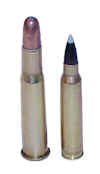 I actually started reviewing .30/30 loading data while I was researching .223 Contender loads. It appeared possible to get within 5% of the 20″ rifle velocity with a 14″ Contender barrel. Reducing a barrel from 14″ to 10″ cost 400 ft/sec, but tables indicated reducing from 20″ to 14″ carried only a 50 ft/sec velocity penalty.
I actually started reviewing .30/30 loading data while I was researching .223 Contender loads. It appeared possible to get within 5% of the 20″ rifle velocity with a 14″ Contender barrel. Reducing a barrel from 14″ to 10″ cost 400 ft/sec, but tables indicated reducing from 20″ to 14″ carried only a 50 ft/sec velocity penalty.
I wanted to see if I could push the velocity issue, without blowing out cases. Even though the Contender is a strong action, .30/30 cases are designed for about 38,000 CUP and I was concerned they might fracture if I over did some of the loads.
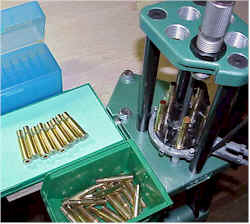 Of course, before I could start reloading, I had to pick up any tools and fixtures unique to this cartridge:
Of course, before I could start reloading, I had to pick up any tools and fixtures unique to this cartridge:
Shell plate for the Ammo Master
Shell holder for the APS press
Reloading die set
About $60 worth of equipment. Typically, the cost of shell plates and holders is spread over several similar cartridges, but the cartridges that shared the #2 shell holder designation looked like the who’s who list of obsolete cartridges.
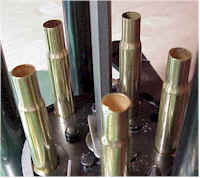 I used both new unprimed, and once fired Winchester brass for these loads. The new cases seemed a little flimsy at .011 thickness. The case mouths were moderately deformed as received in bulk, and had to be cleaned up with a pass through the sizing die.
I used both new unprimed, and once fired Winchester brass for these loads. The new cases seemed a little flimsy at .011 thickness. The case mouths were moderately deformed as received in bulk, and had to be cleaned up with a pass through the sizing die.
I was surprised to find, after checking thickness, they were actually .002 thicker than some 20 year old .30/30 cases. They were, however, about .002″ thinner than .243 or 7MM Mag brass. I assume this is consistent with the lower chamber pressure design of the .30/30 case.
Since the comparison between the Marlin and Contender would be based only on muzzle velocity and 100 yard accuracy, and the 336 was limited to flat nose bullets, I used Speer Hot-Cor flat nose soft points.
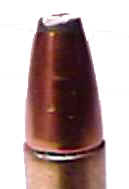 These flat nose bullets have a cannelure. A groove cut in a jacketed bullet is typically used when the case is used to crimp the bullet in place. It makes sense when the cartridge will be loaded into a tubular magazine and probably get bumped around during recoil. Because I thought this mechanical retention might effect chamber pressure and have an effect on velocity, I crimped all rounds.
These flat nose bullets have a cannelure. A groove cut in a jacketed bullet is typically used when the case is used to crimp the bullet in place. It makes sense when the cartridge will be loaded into a tubular magazine and probably get bumped around during recoil. Because I thought this mechanical retention might effect chamber pressure and have an effect on velocity, I crimped all rounds.
Range Results
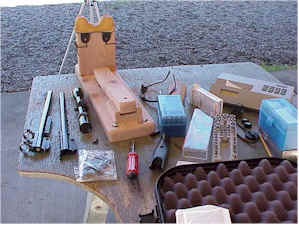 Much of the day was spent swapping barrels and changing out scopes. If you missed it before, there is a 5 second movie of the T/C being fired.
Much of the day was spent swapping barrels and changing out scopes. If you missed it before, there is a 5 second movie of the T/C being fired.
The Marlin was fired with standard metallic sights, with a rear leaf that was large enough to simultaneously covered two entire bullseyes. I’ll chalk that up as the reason the carbine sprayed a 5″ group across the top of the paper. It’s a great gun in the field, but never was much at the range.
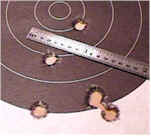 No, that isn’t bird shot. I chased the scope settings around for a little bit, putting tight two shot groups all over the place, then picked a spot and fired a five shot group. That’s 1.75″, but the sun was in my eyes, my elbow really hurt and I think the guy next to me kept bumping my bench… If you have time, I can think of more excuses. Next time I’m going have the scope in the Leupold mounts, and I won’t be peering through chronograph skyscreens.
No, that isn’t bird shot. I chased the scope settings around for a little bit, putting tight two shot groups all over the place, then picked a spot and fired a five shot group. That’s 1.75″, but the sun was in my eyes, my elbow really hurt and I think the guy next to me kept bumping my bench… If you have time, I can think of more excuses. Next time I’m going have the scope in the Leupold mounts, and I won’t be peering through chronograph skyscreens.
Marlin / Contender chronograph comparison
| Bullet | Powder | Wt grains | Primer | Contender MV ft/sec 14″ Barrel |
Marlin MV ft/sec 20″ barrel |
| 150 | IMR4895 | 35.5 | CCI LR | 2234 | 2215 |
| – | AA2520 | 35.0 | CCI LRM | 2205 | 2162 |
| – | Win748 | 37.0 | CCI LRM | 2213 | 2247 |
| – | Win 748 | 37.3 | CCI LRM | 2215 | 2268 |
| – | Factory Winchester PP | 2196 | 2202 | ||
Winchester 748 was the only powder that had the rifle producing higher velocities than the pistol. I assume that is a comment on burn rate, with the 748 being slower than the others. The Contender was definitely a lot of fun to shoot and, I thought, had a lot of unexercised potential for accuracy and velocity. None of these loads taxed either the Marlin or the Contender, not even close, and I noticed that even a couple of tenths of a grain increase with 748 was still causing MV to measurably rise. I’ll take this as a sign the combination was not tapped out.
I’ve already noted what makes the Contender and the 336 different, but in numerous ways they are the same. Both a very simple guns, basic actions, exposed hammers, and probably more beefy then necessary.
Generally, the Contender can deliver better ballistic performance than the Marlin, offers a more cartridge components options, and clearly is more accurate. The Marlin carries more shots and is probably less demanding of shooter’s skill for typical field use. If I needed a gun for utility, I’d select the Marlin. If I wanted something for fun and to experiment with, it would be the Contender. I think the Marlin will be packed up again and saved for backup duty.
Some closing notes
 The UPS truck dropped a package that included some Hornady 165 grain SPBT’s with a ballistic coefficient of .435, compared to the Speer flat nose 150 at less than .250. The operating range for this bullet is 2200 – 3300 fps. The Contender would not meet the velocity criteria, but I thought the additional length might help bullet stability and lead to tighter groups at the range.
The UPS truck dropped a package that included some Hornady 165 grain SPBT’s with a ballistic coefficient of .435, compared to the Speer flat nose 150 at less than .250. The operating range for this bullet is 2200 – 3300 fps. The Contender would not meet the velocity criteria, but I thought the additional length might help bullet stability and lead to tighter groups at the range.
“Understanding Ballistics ” has an extensive section on bullet stability, gyroscope effect and rifling twist determination. It also has the simplified Greenhill formula for calculating correct twist rates for a particular bullet, or determining what bullet would work best with a specific twist rate.
Twist = 150 x BD
BL/BD
BL=Bullet Length BD=Bullet Diameter all stated in inches
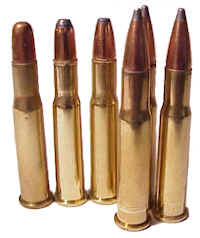 The Speer flat nose 150 grain has an overall length of .922″, which equates to a twist rate of 1:15. Neither the Marlin 1:12 or Contender 1:10 meet this twist spec. The longer 1.22″ Hornady 165 grain should stabilize at a twist of 1:11.5.
The Speer flat nose 150 grain has an overall length of .922″, which equates to a twist rate of 1:15. Neither the Marlin 1:12 or Contender 1:10 meet this twist spec. The longer 1.22″ Hornady 165 grain should stabilize at a twist of 1:11.5.
I don’t understand the fast twist of the Contender. Most load data for the Contender 14″ is for 150 grains or lighter, all short bullets, and the .30/30 case capacity isn’t going to push long heavy bullets along. Anyway, the longer spitzer should offer an accuracy improvement.
Pictured left to right: 150 grain – Rem Core Loc, Winchester Power Point, Speer Flat Nose and 165 Hornady Spitzer Boat Tails.
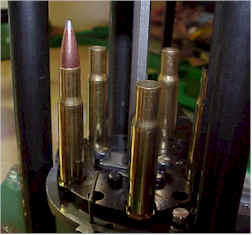 Almost looks like a long necked .30-40 Krag. I tried to keep the COL to 2.720″ which required seating just at the top edge of the bullet cannelure. Because none of this ammo will see use in anything other than the Contender, I didn’t crimp the case to the bullet.
Almost looks like a long necked .30-40 Krag. I tried to keep the COL to 2.720″ which required seating just at the top edge of the bullet cannelure. Because none of this ammo will see use in anything other than the Contender, I didn’t crimp the case to the bullet.
The reloading process was pretty uneventful. I used 36 grains of Winchester 748 and CCI large rifle primers. Powder was well below the shoulder and the base of the boat tail seated level with the base of the neck.
I’ll post the final results next week.
Thanks
Joe

Email Notification